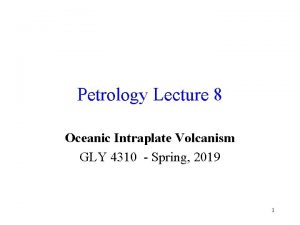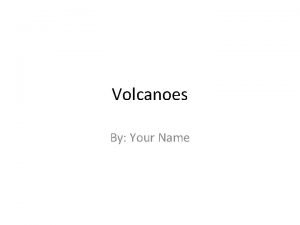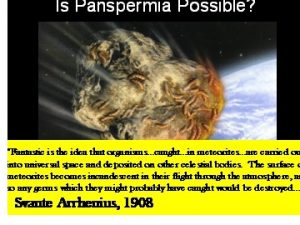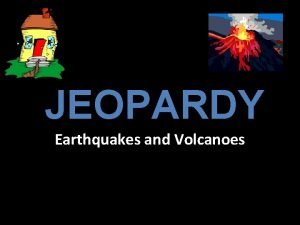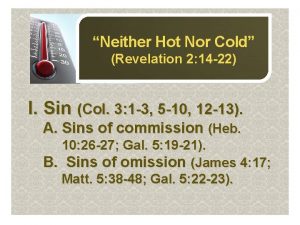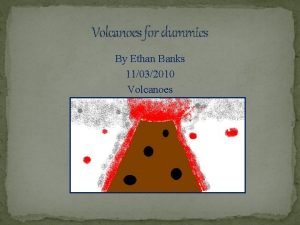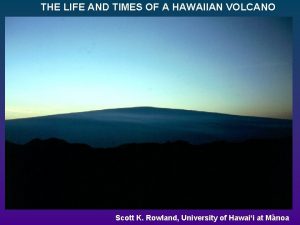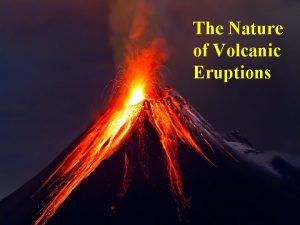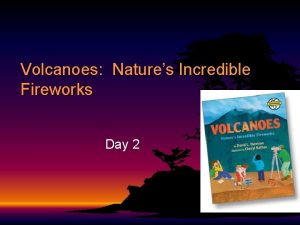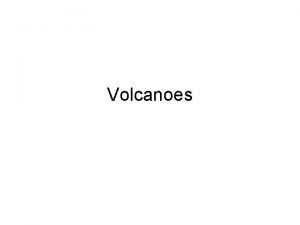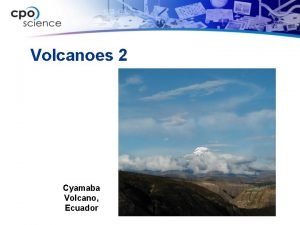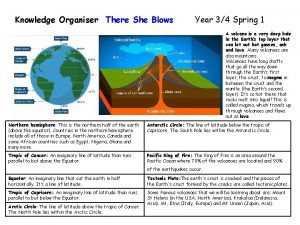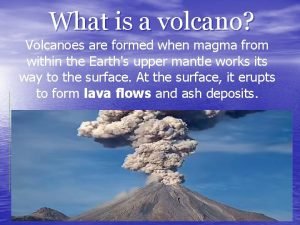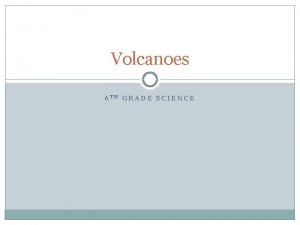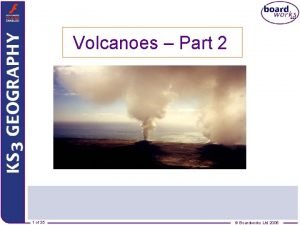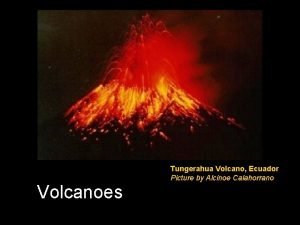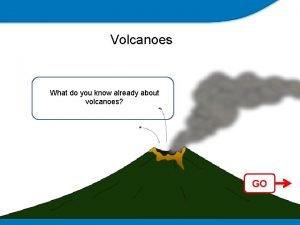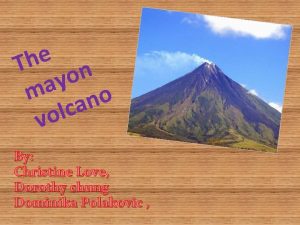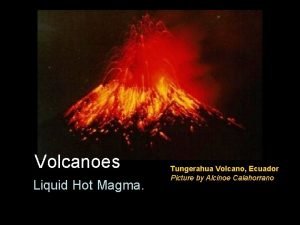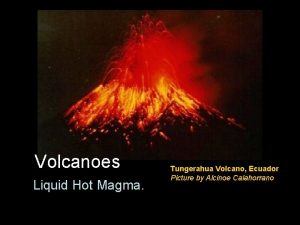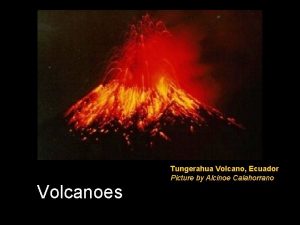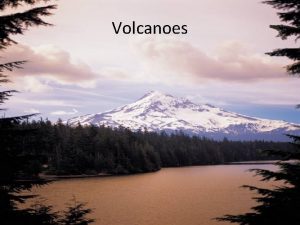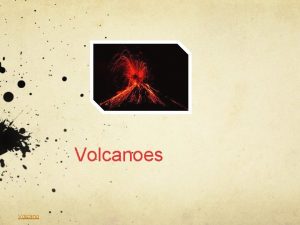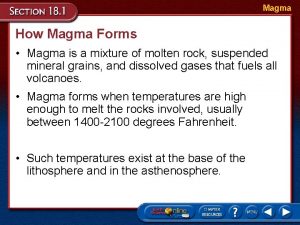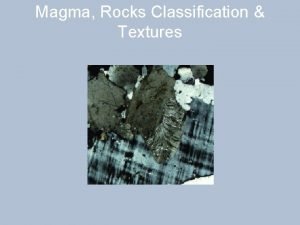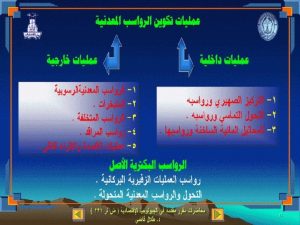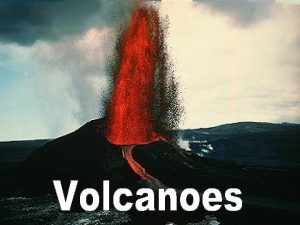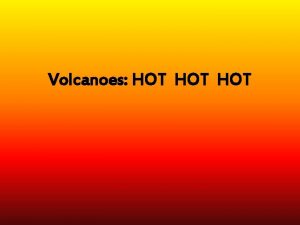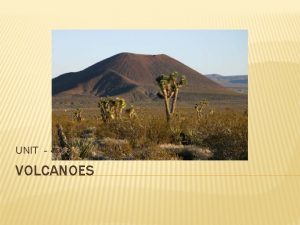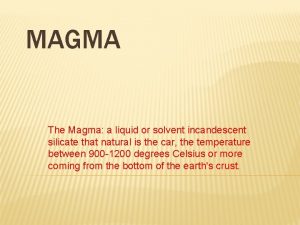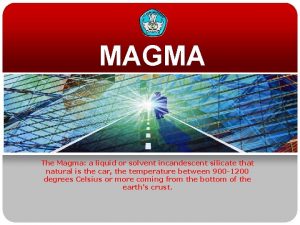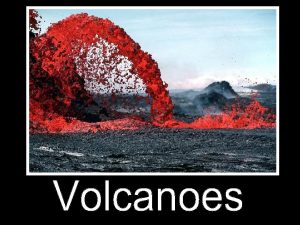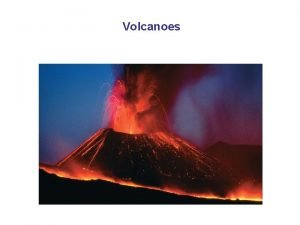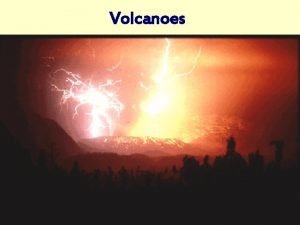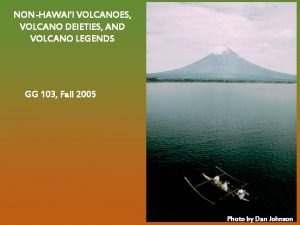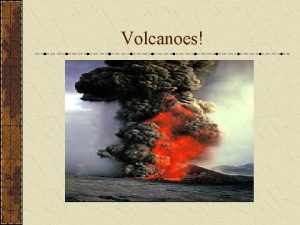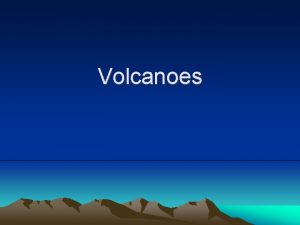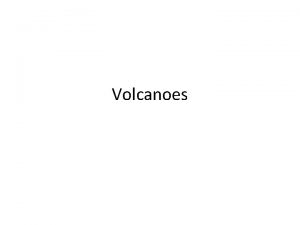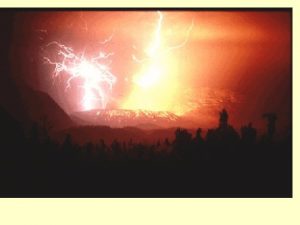Volcanoes Liquid Hot Magma Tungerahua Volcano Ecuador Picture



























- Slides: 27


Volcanoes Liquid Hot Magma. Tungerahua Volcano, Ecuador Picture by Alcinoe Calahorrano

Volcano Stats • Definition of Volcano – Mountain that forms when molten rock (magma) is forced to the Earth’s surface • Number of active volcanos = ? – 20 erupting right now (50 -60/year) (160/decade) • Number of volcanologists = 1, 500

Volcanoes are often cone-shaped, but they can take other shapes too. They are formed when molten, sticky rock called magma, forces its way through a crack in the Earth’s crust. The melted rock that spills out of the crater on the top of the volcano is called lava. The lava destroys everything in its path because it is very, very hot!

Lava flow Volcanic Eruptions • Nonexplosive Eruptions Lava fountain • Explosive Eruptions What is Lava? -magma that flows onto the Earth’s surface

Eruption patterns There are different levels of eruption: 1. If it easy for the gases to escape, then the eruption is very gentle. However, the lava is very runny and can move very fast. 2. Gas builds up and lumps of rock (‘bombs’) and ash burst out of the volcano. This makes the lava thick and sticky.

3. This is the fiercest eruption of all because the gases and magma become trapped inside the volcano. This causes a huge explosion, which can be big enough to remove the top of the whole mountain!

Volcanoes form around vents that Vents Lava release magma onto the Earth’s surface. Magma chamber

The Composition of Magma Determines whether it is explosive or not! • High water content – More likely to be • High !!! content – More likely to be – Why? !!! • Silica has a thick, stiff consistency – Flows slowly – Tends to Harden in the volcano’s vent

What Erupts from a Volcano? Lava can be thick or thin. Pahoehoe Pillow lava Blocky lava

What Erupts from a Volcano? Pyroclastic material • Rock fragments created by eruptions • magma explodes from volcano and solidifies in the air • existing rock is shattered by powerful eruptions Lapilli Volcanic bombs Volcanic blocks Volcanic ash

How do volcanoes affect the Earth? Flows and Fallouts • hot ash can flow really quickly • Knock down buildings • Dam rivers (flooding/drought) • Kill crops and livestock Climatic Changes • Ash & Gases can block sunlight • Drop average global temperature noticeably

Types of Volcanoes Shield volcano Cinder cone volcano Composite volcano

The Big Island of Hawaii, the largest volcano on earth, is an active shield volcano.

Stratovolcanoes are high and steep-sided and they are form from violent eruptions of magma. Stratovolcanoes are found at almost all convergent plate boundaries, where subduction makes viscous and gas-rich magma.

What causes volcanoes? The Formation of Magma • Mantle rock melts when the temperature increases or the pressure decreases.

What causes volcanoes? Where Volcanoes Form • Tectonic Plate Boundaries!!! ~75% world’s active volcanoes in Ring of Fire

How do volcanologists predict eruptions? • Measuring Small Quakes – Before eruption, increase in number & intensity • Measuring Slope – Bulges may form with magma (tiltmeter) • Measuring Volcanic Gases – Outflow of volcanic gases • Sulfur dioxide, carbon dioxide • Measuring Temperature from Orbit – Measure changes in temperature over time

Volcanic Explosivity The violence of a volcano’s eruption is expressed by the Volcanic Explosivity Index (VEI). Values for the VEI range from 0 to 8, and are based on three criteria: • the volume of material (lava and particles) erupted • the height of the eruption column • how long the eruption lasts The larger the VEI value, the larger the eruption.

The violence and explosiveness of a volcanic eruption depends on: The amount of time since the last eruption, The magma’s viscosity The magma’s gas content.

The longer a volcano has been dormant, the more violently it may erupt in the future.

Viscosity is a measure of how easily a liquid will flow.

Magma with just a little bit of gas in it flows out of a volcano as relatively quiet lava. Magma with a lot of gas will blow the volcano apart violently. The higher the gas content, the more violent the eruption.

Lava flows burn and destroy whatever they overrun. This hazard relates mostly to property damage, not fatalities. Lava flows are not life threatening if you keep your distance!

Pahoehoe lava flow from Kilauea destroying houses

Before After

GLOSSARY Bomb – a lump of rock thrown out in an eruption Crater – a deep hollow at the top of a volcano Crust – The top layer of the Earth Eruption – the release of gases, magma and rock from a volcano Lava – melted rock that flows down the volcano Magma – melted rock inside the Earth Molten – melted, liquid Vent – a crack on the side of a volcano where magma can escape
 Perbedaan hot lava dan hot lava volcano
Perbedaan hot lava dan hot lava volcano Oni magma volcano tamer
Oni magma volcano tamer Taal volcano is an example of_______ volcano
Taal volcano is an example of_______ volcano Hot magma rises to the surface
Hot magma rises to the surface Hot spot volcano
Hot spot volcano Classification of liquid dielectrics
Classification of liquid dielectrics Lever arm rule liquid-liquid extraction
Lever arm rule liquid-liquid extraction Be either hot or cold
Be either hot or cold White hot vs red hot temperature
White hot vs red hot temperature Hot and cold forming
Hot and cold forming Paboeboe
Paboeboe A'a hawaiian
A'a hawaiian Magma
Magma Volcanoes nature's incredible fireworks
Volcanoes nature's incredible fireworks Factor affecting volcanic eruption
Factor affecting volcanic eruption Ring of fire volcanoes
Ring of fire volcanoes Most volcanoes occur __________. *
Most volcanoes occur __________. * Cotapoxi
Cotapoxi Volcanoes of italy map
Volcanoes of italy map Volcanoes knowledge organiser
Volcanoes knowledge organiser Types of volcanoes
Types of volcanoes Volcano diagram for kids
Volcano diagram for kids Name volcanoes
Name volcanoes Magma chamber
Magma chamber Active volcanoes map
Active volcanoes map What do you already know about volcanoes
What do you already know about volcanoes Extreme earth
Extreme earth Interesting facts about mt mayon
Interesting facts about mt mayon

